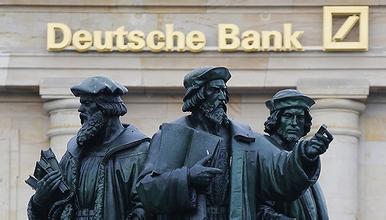德意志銀行
Two’s company
兩人成伴
Hard questions loom for the new bosses of Germany’s national banking champion
德國最大銀行的新總裁們面臨著隱隱出現的棘手問題
Dual passports
雙重護照
IN THE entrance to Deutsche Bank’s London office is a giant silver ball with a hole in the middle that offers an inverted reflection of the viewer and bank. The sculpture, which is called “Turning the World Upside Down III”, is a fitting metaphor for the changes sweeping the banking industry. Deutsche itself has had a good crisis, eschewing direct help from the German government and rebuilding its balance-sheet to regain its place as the biggest bank in Europe by total assets. Yet its world is turning upside down, too.
德意志銀行倫敦分行的入口處有一巨型銀球,球中有洞,窺洞中可見觀者與德行的倒影。這尊名為“顛倒世界III”的雕塑對于席卷銀行業的變革浪潮是一個貼切的暗喻。德意志銀行獨善其身,很好的度過了危機,他們避開德國政府的直接援助,重建自己的資產負債表,欲借資產總額重歸歐洲最大銀行之席。然而,德行的世界也正發生著翻天劇變。
The most obvious upheaval is in the executive suite. On June 1st two new co-chief executives, Jürgen Fitschen and Anshu Jain, will take over from Josef Ackermann, who has run the bank for a decade. Mr Fitschen, the boss of Deutsche’s German operations, is a far less controversial figure than Mr Jain, an Indian-born, American-educated British citizen who has propelled Deutsche’s rise in investment banking. Mr Jain’s elevation is a remarkable one in a corporate culture as crusty as Germany’s: most bosses are either German or native German-speakers from Switzerland or Austria. His appointment has also provoked a backlash from an “old guard” within Deutsche who fear the growing influence of the investment bank, which is based almost entirely in London and is staffed largely by non-Germans.
管理層的劇變尤為明顯。新任聯合首席執行官安舒·賈恩(Anshu Jain)和尤爾根·菲茨岑(Jurgen Fitschen)將于6月1日走馬上任,從執掌德意志銀行十年的約瑟夫·阿克曼(Josef Ackermann)的手中接過大權。論爭議性人物,德行德國業務主管菲茨岑先生遠不如賈恩先生。英國人賈恩先生出生于印度,求學于美國,他一手推動了德意志銀行在投資銀行中的崛起。德國企業文化素來頑固保守,高層大都以德國人或瑞士、奧地利的德語區人士為主,故賈恩先生的高升著實令人驚嘆。這次任命同樣也激起了德行內部“保守派”的對抗情緒——德行的投行部幾乎完全設立在倫敦,員工多為非德裔,投行部日益增大的影響力令“保守派”擔憂。

Yet the focus on Mr Jain is a distraction. The bank’s biggest task is not to convince investors that it has the right executives in place—big investors and fund mangers see the new team as more shareholder-friendly than the old one. It is to prove that it has enough capital and liquidity to satisfy regulators and that it can adapt its business model to a topsy-turvy landscape.
然而對賈恩先生的關注是件分心事。 依大投資者和基金管理人之見,新領導團對股東比上任要友好的多,因此德行目前的最大任務不是說服投資者,自己選對了領導人選,而是向他們證明,自己有足夠的資本和流動資金來滿足監管機構的要求,并能在業界一片顛倒混亂的情況下調整自己的業務模式。
Start with capital Deutsche has total assets of close to 2.1 trillion ($2.7 trillion), and total equity of 56 billion.In terms of simple leverage, the bank has just 1 in equity backing every 38 of assets.
先談談資本。德行的資產總額約2.1萬億歐元(2.7萬億美元),權益總額560億歐元。而就簡單杠桿率而言,德行每38歐元的資產僅兌換1歐元股本。
The bank argues that these figures are misleading. By netting off derivatives that offset each other and making a few other adjustments, it calculates its leverage ratio at 21 times, still considerably higher than most peers in Europe and America.
德行辯稱上述數據有誤導性。在扣掉了可互相抵消的衍生品,進行其他幾項微調之后,德行自我估算的杠桿率為21倍,這仍舊遠高于多數歐美同類銀行。
Like other banks, Deutsche also argues that a simple leverage ratio is not much use in assessing the risks that lenders take.
與其他銀行一樣,德行也爭論道,說簡單杠桿率在評估貸方承擔的風險時并無大用。
So a second measure to consider is its levels of risk-weighted assets (RWAs), in which the size of the balance-sheet is adjusted to reflect its riskiness.
如此一來,第二種要考慮的評估方法就是銀行的風險加權資產等級,即通過資產負債表的規模標準推算貸方的風險。
Using RWAs as a lens is like looking at Deutsche Bank through its lobby sculpture, with the picture turned on its head.
以風險加權資產為透鏡,就如同透過倫敦分行的大堂雕塑審視德意志銀行,所見景象皆顛倒。
On this view Deutsche is a midsized and reasonably well-capitalised bank, ranking just eighth in size in Europe. Deutsche’s risk-weighted assets are calculated to be a mere 17% of its gross assets, compared with 53% at JPMorgan Chase and 25% at Barclays.
依此觀點看,德行就是一家中型、資本相當雄厚的銀行,論大小僅位列歐洲第八。德行的風險加權資產僅占其總資產的17%,與之相比,摩根大通為53%,巴克萊銀行為25%。
Different accounting standards and the high quality of German corporate and mortgage lending explain some of this gap, but not all. “Deutsche is the most complex institution I have to deal with,” confesses one banking analyst. The question many investors ask is which of these two pictures is more accurate.
不同行的會計準則,高質量的德國企業和德國抵押貸款只能解釋這些差距中的部分原委,卻無法解釋全部。一名銀行分析師坦誠的說,“德意志銀行是我遇到過的最復雜的機構。”眾投資者需要問的問題是,以上兩種情況哪一個更貼近事實。
Part of the answer is already being provided by regulators, who are tightening the definitions of what counts as core capital, capping total leverage and carefully scrutinising the risk-weightings that banks apply.
監管機構早已給出了部分解答。近日來,監管機構一直在緊縮核心資本的界定標準,壓制全部杠桿作用,并謹慎詳核銀行上報的風險加權資產。 翻譯:王葭葦












